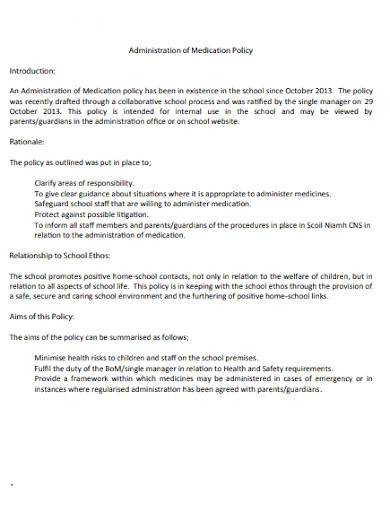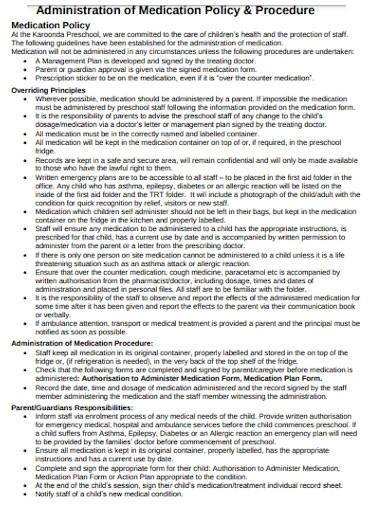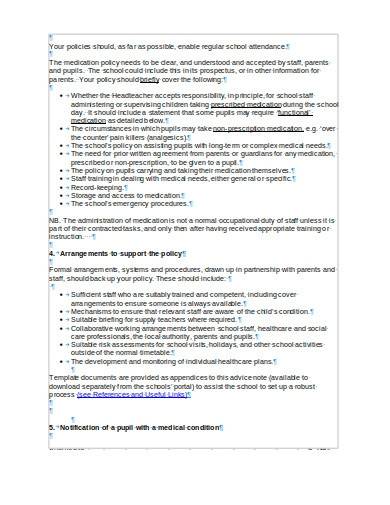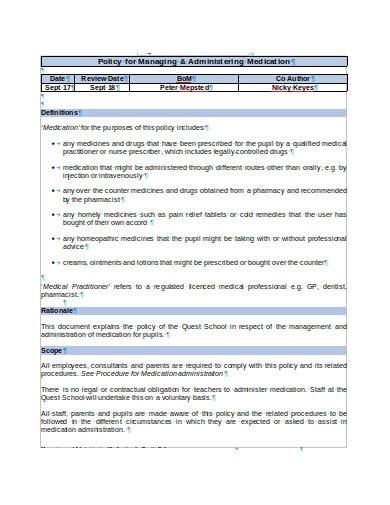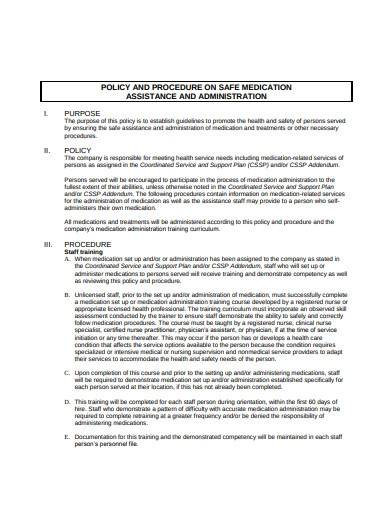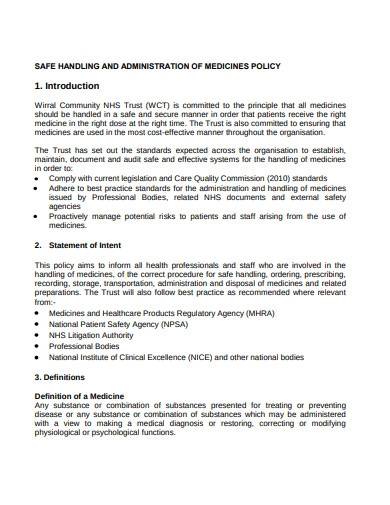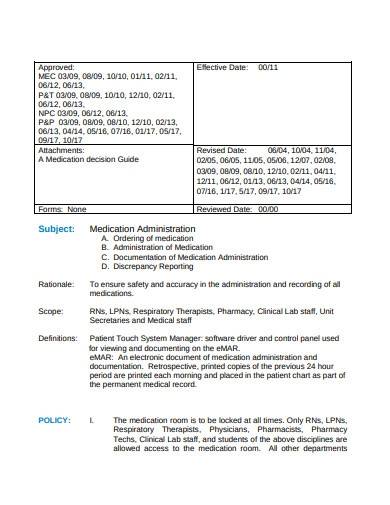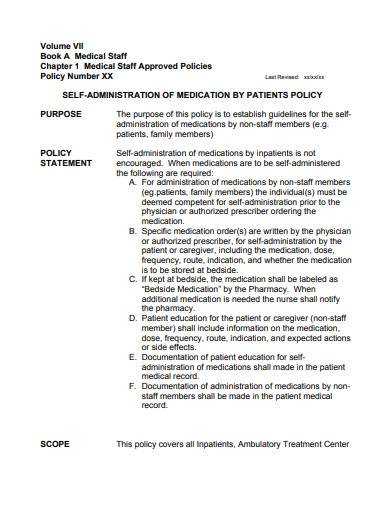Medications are used to cure most diseases and help people recover from certain illnesses. The administration of medication is one of the first non-invasive treatment plan that doctors recommend to their patient. With that being said, it’s very important to be knowledgeable about medication administration policies. In this article, we have gathered downloadable administration of medication policy samples that you can actually use as reference. We have also included basic information about medication administration in the details below.
FREE 10+ Administration of Medication Policy Samples & Templates
1. 401K Administration Policy Template
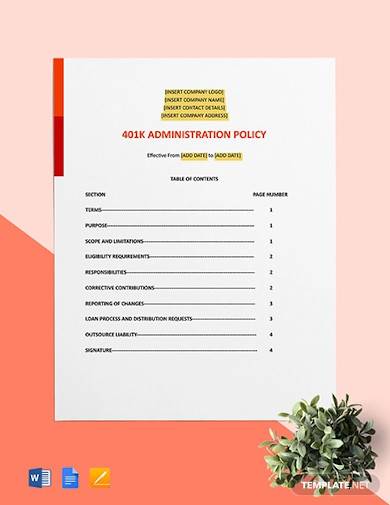
2. Administration of Medication Policy Template
3. Administration of Medication Policy & Procedure
4. School Administration of Medication Policy
5. Sample Administration of Medication Policy
6. Managing & Administration of Medication Policy
7. Assistance Administration of Medication Policy
8. Simple Administration of Medication Policy
9. Safe Handling and Administration of Medicines Policy
10. Basic Administration of Medication Policy
11. Administration of Medication Policy by Patients Policy
What Is an Administration of Medication Policy?
A medication administration policy is a set of guidelines that all health professionals follow when administering any type of drug or medication to their patients. The policy must be strictly implemented. One of the goals of a medication administration policy is to prevent or minimize medication errors and protect the well-being of patients and other individuals who are self-administering medications or drugs. Most medications do not require a written consent from the patient. But when it is needed, the patient must sign a consent form before the medication is administered.
What Are the Eight Rights of Medication Administration?
Nurses use the eight rights of medication administration for safe medication administration and prevention of medication errors. This nursing medication administration guidelines serves as a reminder of the correct medication administration procedure. The eight rights of medication administration are as follows:
1. Right patient – Identifying the right patient by checking their name on the patient’s chart and letting them identify themself.
2. Right medication – This is done by checking the label on the medication and comparing it with the doctor’s order.
3. Right dose – Check the doctor’s order and do your own calculations to ensure that the right amount will be administered to the patient.
4. Right route – This still involves checking the doctor’s order and double-checking if it is the appropriate route. Also, determine if the patient can take the medication through the ordered route.
5. Right time – Confirm how frequent the medication should be taken, the right timing, and when the last dose was given.
6. Right documentation – Use medication administration documentation standards when charting the time, route, and other specifics.
7. Right reason – Confirm the reason why the patient is given such medication. Check their health history and diagnosis.
8. Right response – Check for the desired effect of the drug. If a patient who is given antihistamines should feel relief from itching a couple of minutes after the drug is administered.
How To Make an Administration of Medication Policy
Writing medication administration policies is a task intended for health professionals. It’s clearly difficult to make one with very limited knowledge of the field of medicine. We have here the easiest steps that will help you prepare for making a medication administration policy.
1. Outline the Different Parts/Sections of the Policy
Decide on how many sections you want your medication administration policy to be. With a blank outline template, you’ll know what other information you’ll need to gather and prepare for the policy.
2. Make a List of the Information You Must Include
There are a lot of drug safety guidelines that must be included in a medication administration policy. Makes sure to list down the information that is both useful and applicable to your institution.
3. Work with a Team
A medication administration policy needs a lot of planning. Brainstorm with your medical policy team. By doing this, a lot of ideas and their rationale are made available.
4. Prepare a Policy Statement
Policy statements must be clear and concise. It must prescribe the behaviors and methods that are acceptable when administering medication.
5. Look at Existing Policies
Existing medication administration policies make excellent reference material. If an organization already has one, they’ll just need to update the existing document thoroughly. Of course, the task is never easy, but it can be done.
FAQs
Why is a medication administration policy important?
A medication policy is important because it helps ensure the safety of patients who are receiving medication from health professionals in hospitals and other medical facilities. The policy also states that only authorized medical professionals are allowed to administer certain types of medication. This way, harm and death from wrong drug administration can be minimized if not prevented. Medication administration policies also prove an institution’s commitment to keeping their patients safe from harm. Medical malpractice is also an issue that is mitigated with a well-implemented medical administration policy.
Who is legally allowed to administer medication?
Licensed doctors and registered nurses are legally authorized to administer medication to patients in the hospital. When administering medications, these professionals are held liable for their own actions, so they are expected not to make mistakes. Other health professionals are subject to certain laws and legislations, including national and state regulations.
Does medication administration require training?
Licensed doctors and registered nurses are trained in school to administer medication properly. However, there are specific medications that require special training and certification before any of the mentioned professionals can do them. Aside from the type of medication, some administration routes must also only be performed by certified professionals. This includes intravenous medication administration and IV insertion.
A single mistake can lead to a patient’s death. That is why there is no room for mistakes in the medical field. Medication administration policies exist for such reason, and they must be strictly followed all the time.
Related Posts
FREE 30+ Fee Policy Samples in PDF | MS Word
FREE 29+ Work Policy Samples in PDF
FREE 20+ Recruitment Policy Samples in PDF
FREE 20+ Policies and Procedures Samples in MS Word | Google Docs | PDF
FREE 50+ Feedback Policy Samples in PDF | MS Word
FREE 10+ High School Credit Policy Samples & Templates in MS Word | PDF
FREE 10+ Concurrent Class Policy Samples & Templates in MS Word | PDF
FREE 10+ Student Freedom of Expression Policy Samples in PDF
FREE 10+ Suicide Prevention Policy Samples in MS Word | PDF
FREE 10+ Plagiarism/Cheating Policy Samples in MS Word | PDF
FREE 50+ Policy Approval Samples in PDF | MS Word
FREE 10+ Related Personnel Policy Samples in MS Word | PDF
FREE 10+ Suspension And Expulsion Policy Samples in MS Word | PDF
FREE 10+ Uniform Complaint Policy and Procedure Samples in PDF
FREE 10+ Bullying Policy Samples in MS Word | PDF

